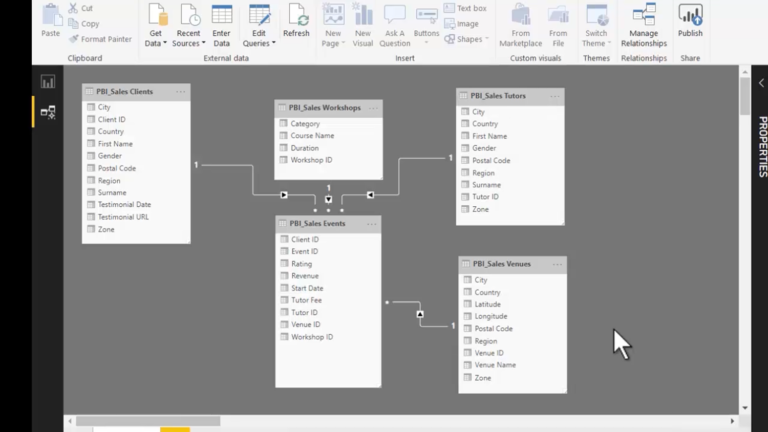Column Sorting Secrets – Empower Your Data Analysis with Power BI’s Hidden Gem!
In the world of data analysis, the ability to sort columns is a hidden gem that can unlock valuable insights and streamline your Power BI experience. Sorting allows you to organize your data in a specific order, making it easier to identify patterns, trends, and outliers. In this article, we will explore the secrets of column sorting in Power BI and how it can empower your data analysis efforts.
Introduction
When working with large datasets in Power BI, it can be challenging to make sense of the information at first glance. That’s where column sorting comes in handy. By arranging your data in a logical order, you can quickly spot the most significant values, drill down into specific categories, and identify relationships between different variables.
Understanding Column Sorting in Power BI
What is column sorting?
Column sorting refers to the process of arranging data in ascending or descending order based on the values in a specific column. It allows you to reorder the rows in a table or matrix visualization based on a chosen column’s values.
Why is column sorting important in data analysis?
Column sorting is crucial in data analysis as it helps you gain a better understanding of your data. By sorting columns, you can:
Identify the highest or lowest values in a dataset.
Analyze trends and patterns within your data.
Group and summarize data based on specific criteria.
Filter and visualize sorted data to highlight insights effectively.
Sorting Data in Power BI
In Power BI, sorting data is a straightforward process. Let’s explore some common sorting techniques you can apply to your datasets.
Sorting columns in ascending order
To sort a column in ascending order:
Select the column you want to sort.
Right-click on the column header and choose “Sort Ascending” from the context menu.
This action will rearrange the rows in your visualization, displaying the column values from the lowest to the highest.
Sorting columns in descending order
To sort a column in descending order:
Select the column you want to sort.
Right-click on the column header and choose “Sort Descending” from the context menu.
Power BI will reorder the rows in your visualization, displaying the column values from the highest to the lowest.
Sorting by multiple columns
Power BI also allows you to sort your data by multiple columns. This feature is useful when you want to sort your dataset based on multiple criteria.
To sort by multiple columns:
Select the column you want to sort first.
2. Hold the Ctrl key and select the additional columns you want to include in the sorting.
Right-click on any of the selected column headers and choose “Sort Ascending” or “Sort Descending” from the context menu.
Power BI will arrange the rows in your visualization based on the selected columns’ values, prioritizing the first column chosen for sorting.
Using Advanced Sorting Options in Power BI
Power BI offers advanced sorting options that go beyond simple ascending or descending order. Let’s explore these options to enhance your data analysis.
Sorting by a custom column
In some cases, you may want to sort your data based on a calculated or custom column. Power BI allows you to create new columns using DAX (Data Analysis Expressions) and sort your data based on these custom columns.
To sort by a custom column:
Create a new column using DAX formulas that define the desired sorting logic.
Select the column you want to sort.
Right-click on the column header and choose “Sort Ascending” or “Sort Descending” from the context menu.
Power BI will sort the data based on the values in the custom column you created.
Sorting by hierarchy
If your data includes hierarchical relationships, Power BI enables you to sort data based on these hierarchies. This feature is particularly useful when working with organizational charts, product categories, or geographical data.
To sort by hierarchy:
Enable the hierarchy functionality for the relevant columns in your dataset.
Select the hierarchical column you want to sort.
Right-click on the column header and choose “Sort Ascending” or “Sort Descending” from the context menu.
Power BI will sort the data based on the hierarchy, maintaining the relationships between different levels.
Sorting by another column’s values
In Power BI, you can also sort your data based on the values of another column. This technique is useful when you want to sort one column according to the values in a different column.
To sort by another column’s values:
Select the column you want to sort.
Right-click on the column header and choose “Sort by Column” from the context menu.
Select the column whose values will determine the sorting order.
Power BI will rearrange the rows based on the chosen column’s values, irrespective of the column you initially selected.
Leveraging Sorting for Data Analysis
Sorting columns in Power BI opens up a world of possibilities for data analysis. Here are some ways you can leverage sorting to gain valuable insights from your datasets.
Identifying trends and patterns
Sorting data allows you to identify trends and patterns more easily. By sorting a column in ascending or descending order, you can quickly spot the highest or lowest values, helping you understand the data distribution and outliers. This can lead to valuable insights and potential areas for further investigation.
Grouping and summarizing data
Sorting columns enables you to group and summarize your data effectively. By sorting based on specific criteria, such as product categories or customer segments, you can bring related data together and perform aggregated calculations. This can help you analyze subsets of your data and draw meaningful conclusions.
Filtering and visualizing sorted data
Once you have sorted your data, you can leverage Power BI’s filtering and visualization capabilities to focus on specific subsets and highlight key insights. Filtering allows you to narrow down your dataset based on sorted columns, while visualizations provide a visual representation of the sorted data, making it easier to communicate findings to stakeholders.
Best Practices for Column Sorting in Power BI
While sorting columns in Power BI can be a powerful tool, it’s essential to follow best practices to ensure optimal performance and accurate analysis.
Sort columns based on business logic
When sorting columns, consider the business logic behind the sorting. Sort the columns based on the criteria that align with your data analysis goals and objectives. Think about the insights you want to uncover and how sorting can help you achieve that.
Use sort order in calculations and measures
When performing calculations or creating measures in Power BI, consider incorporating the sort order of columns. By referencing the sorted columns in your calculations, you can ensure that your calculations reflect the intended logic and maintain consistency with the sorted data.
Avoid sorting too many columns at once
While sorting can be a valuable technique, avoid sorting too many columns simultaneously. Sorting numerous columns can result in slower performance and make your analysis more complex. Instead, focus on sorting the most relevant columns that provide meaningful insights for your analysis.
Conclusion
Column sorting is a hidden gem in Power BI that can greatly enhance your data analysis capabilities. By sorting columns in ascending or descending order, utilizing advanced sorting options, and leveraging sorting for analysis purposes, you can unlock valuable insights and improve decision-making.
Take advantage of Power BI’s sorting functionality to identify trends, group and summarize data, and visualize insights effectively. Remember to follow best practices, such as sorting based on business logic, incorporating sort order in calculations, and avoiding excessive sorting.
Incorporating column sorting in your data analysis workflow empowers you to uncover hidden patterns, make informed decisions, and gain a deeper understanding of your data.
Frequently Asked Questions (FAQs)
Can I sort columns in Power BI based on specific conditions?
Yes, Power BI provides various options to sort columns based on specific conditions, including custom sorting using calculated columns and sorting based on hierarchy or another column’s values.
Does sorting affect the original data in Power BI?
No, sorting in Power BI only affects the visual representation of the data. The original data remains intact and unaffected by the sorting operations.
Can I undo column sorting in Power BI?
Yes, you can undo column sorting in Power BI by selecting the sorted column and choosing the “No Sorting” option from the context menu. This will revert the sorting back to the original order.
How does column sorting impact performance in Power BI?
Sorting columns can impact performance, especially when dealing with large datasets. It’s recommended to sort only the necessary columns and avoid sorting too many columns simultaneously to maintain optimal performance.
Are there any limitations to column sorting in Power BI?
While column sorting in Power BI is a powerful feature, it has some limitations. For example, sorting is not available for certain visualizations, such as card visuals and gauges. Additionally, some sorting options may not be applicable to certain data types or hierarchical structures.














